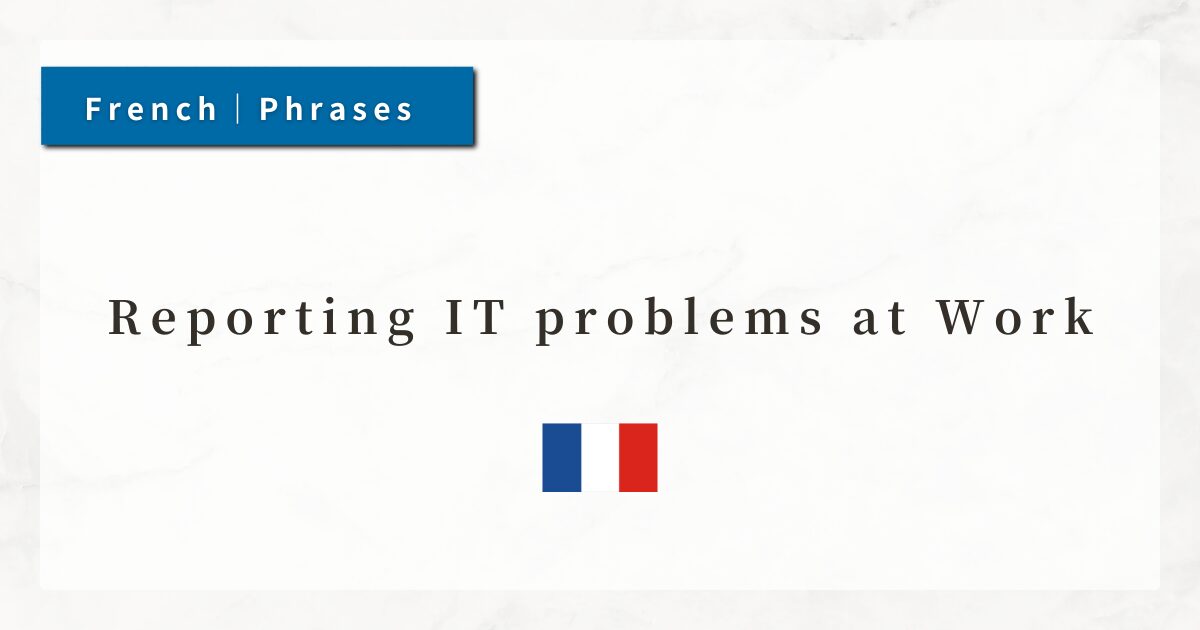#79 Reporting IT problems at Work|French Business Conversation

In the workplace, IT problems can occur suddenly: the computer may stop responding, or you may not be able to connect to the network.
When reporting such issues in French, it is important to use simple and clear expressions.
This lesson explains basic French phrases for reporting IT problems, describing specific situations, and confirming troubleshooting steps.
Dialogue

J’ai un problème avec mon ordinateur.
(There is a problem with my computer.)

Quel est le problème exactement ?
(What exactly is the problem?)

L’écran est bloqué et je ne peux rien faire.
(The screen is frozen and I cannot do anything.)

D’accord. Est-ce que vous avez redémarré l’ordinateur ?
(All right. Have you restarted the computer?)

Oui, mais ça ne marche toujours pas.
(Yes, but it still doesn’t work.)

Je vais envoyer un technicien pour vérifier.
(I will send a technician to check it.)
1. Phrases for Reporting Problems
A common way to say “There is a problem with …” is: “J’ai un problème avec …”
- J’ai un problème avec mon ordinateur.
(There is a problem with my computer.) - J’ai un problème avec la connexion Internet.
(There is a problem with the Internet connection.) - J’ai un problème avec l’imprimante.
(There is a problem with the printer.)
Avoir (to have) expresses the idea of “having a problem = there is a problem.” The preposition avec indicates “concerning/with.”
2. Expressions for Describing the Situation
When reporting issues, adding a description of the specific state makes the problem clearer.
- L’écran est bloqué.
(The screen is frozen.) - Le système est très lent.
(The system is very slow.) - Je ne peux pas me connecter à Internet.
(I cannot connect to the Internet.)
The structure “être + past participle” expresses a state. Example: est bloqué (blocked → frozen).
Negative forms (ne … pas, ne … plus, ne … jamais) are very common in reporting IT issues, so it is useful to review them in advance.
3. Phrases for Confirmation Questions
IT support staff often ask if certain actions have already been tried.
The structure is: “Est-ce que vous avez + past participle … ?” (Have you … ?)
- Est-ce que vous avez redémarré l’ordinateur ?
(Have you restarted the computer?) - Est-ce que vous avez vérifié la connexion ?
(Have you checked the connection?)
“Vous avez + past participle” is the passé composé form.
Adding “Est-ce que … ?” at the beginning is the most common way to form yes/no questions.
4. Expressions for Stating Actions
Once the problem is identified, support staff or colleagues may use the following phrases:
- Je vais envoyer un technicien.
(I will send a technician.) - Nous allons vérifier la connexion.
(We will check the connection.) - Essayez de redémarrer l’ordinateur.
(Please try restarting the computer.)
“Je vais / Nous allons + infinitive” expresses near future (I/We are going to …), useful for stating upcoming actions.
“Essayez de …” means “Please try to …,” a polite way to request action.
Summary
- J’ai un problème avec …
→ to report an issue concisely. - State expressions
→ “être + past participle” or negatives to describe the situation. - Confirmation questions
→ “Est-ce que vous avez + past participle … ?” to ask if something has been tried. - Action responses
→ “Je vais … / Nous allons …” to explain next steps.




